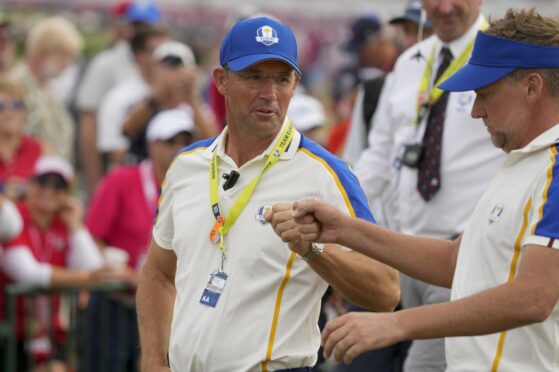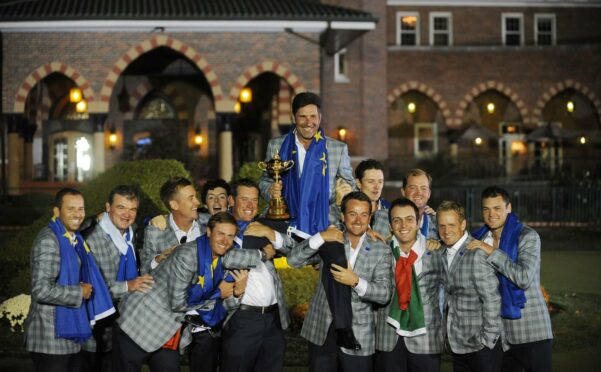There’s nothing that defines a captain in the Ryder Cup more than the result. Win, you’re a genius. Lose, you’re a schmuck.
Doug Ferguson, veteran reporter of the US Associated Press and therefore the world’s most read golf writer, calls golf’s premier event “The Hindsight Cup”. Nowhere in the game is second-guessing more prevalent, and nowhere is the after-scrutiny more intense.
Which makes the legions of words being written about Padraig Harrington’s performance as European captain entirely predictable.
Many of them seem to be predicated on Harrington avoiding scrutiny for the record 19-9 defeat. A claim made after 1000 or so words of…well, scrutiny.
A funny way to avoid scrutiny
Harrington himself is open to talk – it’s his favourite thing to do other than playing golf.
A colleague and I spent the best part of 20 minutes behind the 18th green at Carnoustie with him last week. As usual, he crammed what would be 50 minutes of quotes for a normal person into that time.
It was all about the Ryder Cup. We barely scratched the surface, but from what we did hear he’s clearly got an explanation for every single decision he made, and he really wants to explain his reasoning.
“I’m the sort of person who’d like everybody to know exactly what happened and went on,” he said. Funny way to “avoid scrutiny”, I thought.
I simply don’t have the space to use all he said, and there should be a statute of limitations on Ryder Cup articles. Maybe a book could do it, but the market for the book of a losing captain is likely limited compared to that of a winner.
No Taskforces, please…
It's more than just golf 💙 pic.twitter.com/fKIjSR1ekk
— Ryder Cup Europe (@RyderCupEurope) October 2, 2021
The “avoiding scrutiny” argument seems to emanate from some of Harrington’s team nobly trying to protect him from the scorn of a record 19-9 defeat. But the idea that there should be a post-mortem and reactionary committee formed seems to me to be daft.
Harrington followed the tried and tested Team Europe template, and made some minor adjustments of his own. Were any of them absolutely crucial? Unlikely.
We have to reach for the obvious – the US were better than they’ve ever been, and they holed more putts than Europe did on a course they’d set up to favour them.
The only post-mortem will be on organisational terms. If the next captain wants Harrington to go through the competitive elements then Paddy’s quite willing to do so.
The next captain is likely to be someone who was on the team – playing or back-room – at Whistling Straits. He probably knows all that stuff already.
A narrow defining line between triumph and ignominy
My thought at the end of Whistling Straits was that if that shellacking was the price to be paid for being there for the Belfry, K Club, Celtic Manor, Medinah, Gleneagles and Paris, I’ll take it.
2012 especially. But I’ll also never forget that Saturday night in Chicago with Europe down 10-6 as we chugged free beers (the Ryder Cup is just awesome!) in the press canteen.
We dissected Jose Maria Olazabal’s many errors on the first two days. We decried his captaincy style. It seemed to some to involve mostly pointing at the sky in reverence to his recently deceased friend, Seve.
24 hours later, the Miracle was complete. But Olazabal was just one missed or made putt away from being a bad captain forever.
The R&A’s Seve documentary is a triumph
The R&A are proud to have produced the documentary 'SEVE' which charts the highs and lows of his life and career. Featuring unseen footage and audio, the film bring's SEVE to a new generation.
'SEVE' is available for free on RakutenTV (Europe only) 👉 https://t.co/CO762ZsqP5 pic.twitter.com/73YVA7YwzJ
— The R&A (@RandA) September 29, 2021
It was as well that last Wednesday’s premiere of “Seve – Artist, Fighter, Legend” at the St Andrews Picture House was invitation-only. The unedifying sight of middle-aged men rubbing their eyes was probably not for public consumption.
The bubbling was not confined to the seats. On-screen, even the granite edifices of Gary Player and Bernhard Langer wavered.
Nick Faldo’s interview in the documentary, commissioned by the R&A with the support of Seve’s ex-wife Carmen and his children, was punctuated frequently by emotional pauses. He just about held it together.
The best, not the greatest
A few spectators watching Seve warming up at the '79 Open Championship – pic.twitter.com/Zn7qawnINd
— TheGolfDivoTee™ (@TheGolfDivoTee) September 24, 2021
For golf fans of a certain age – mine, to be exact – Severiano Ballesteros was best golfer who ever lived. R&A chief executive Martin Slumbers called him that, saying that Tiger and Jack could fight over who was the greatest, and I totally get the distinction.
Seve was the most charismatic, dashing, entertaining, and even in his brilliance the most identifiable of superstars.
One assumes Slumbers pushed through this project – the R&A has not been given to making historic documentaries of golf before. They should make a new habit of that, on this evidence.
Even the journalist in me wouldn’t have minded much if this was a hagiography. But it isn’t in the slightest. Seve’s children rolled their eyes at their father’s moods, his penny-pinching, his womanising. Despite all the many things they and we all loved about him, he could be a difficult man.
From this there were real insights in the film. How agonising back pain plagued him even in his great decade from 1978 to 1988. How he was given to periods of real depression.
All the way back to Birkdale
Five best Seve photos.
Golf photographer @Cannonball63 picks his five favourite photos of Seve Ballesteros. pic.twitter.com/YZS6Da5lbr
— GOLFTV (@GOLFTV) September 29, 2021
Most of all, how his family now believe that cancerous brain tumour that ended his time so prematurely and tragically was likely the reason for his moods and confusion in the last ten years of his life.
But there is also the previously unreleased taped interviews. And the vivid footage of the many glories, the Lytham Open triumphs, the Masters wins.
The celebration of the winning putt on the 18th green at St Andrews in 1984, where it seems he almost wills the ball to fall in the side door.
And Birkdale in 1976, that sweltering week when his 19-year-old star rose. That was when 12 year olds – like the one now at this keyboard – saw Seve and Johnny Miller in the final round and thought, ‘you know, this golf thing might be kind of cool.”
“Seve” is available for free from Rakuten.tv. You should see it.

